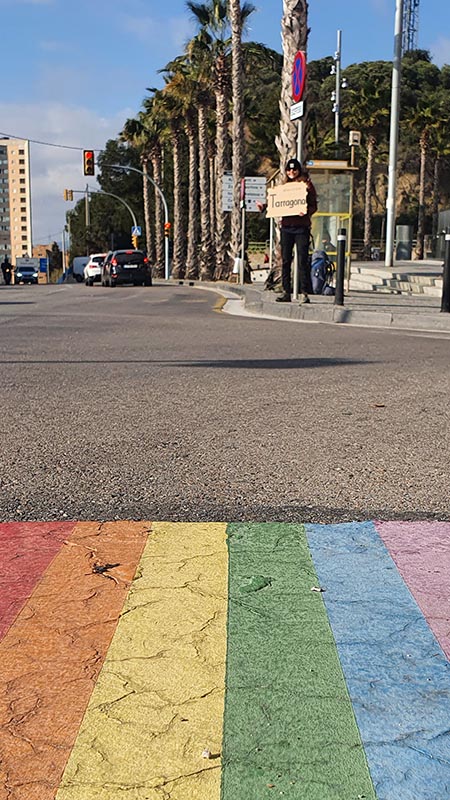In terms of sustainability, hitchhiking has multiple contexts. On the one hand, we evaluate the topic with regard to the three pillars of sustainability. What are the social, ecological and economic effects of this action.
On the other hand, it makes sense to determine the CO2balance in the context of the climate crisis, since it is a type of locomotion and the transport sector has a significant share and influence on global warming. Social and ecological factors are left out of this assessment.
What is hitch hiking?
Hitchhiking describes traveling in someone else's vehicle, which is usually free of charge. The passenger signals his desire to ride with a thumbs up or with a written sign (usually made of cardboard). It is best for the traveler to park at a bay so as not to disturb the flow of traffic.
Is hitchhiking green?
The car as a means of transport in general has a major impact on the environment. The car with a combustion engine emits between one and three kilograms of CO2 for a ten kilometer journey. Since the car and driver would have driven the route anyway, the proportion of fellow passengers is small. It is mostly the additional consumption due to the additional weight and a possible detour that the driver takes when dropping off.
To back up the calculation with a few figures: 100 kg of additional weight can increase the vehicle's fuel consumption by up to 0.3 l per 100 km In addition, it is realistic to expect a detour of 1 km per 100 kilometers driven. Of course, these are the responsibility of the fellow travelers. In addition to the CO2 there are also a proportion of fine dust and nitrogen oxides. The basic prerequisite for road traffic are thousands of square kilometers of surface sealed with asphalt.
Additional consumption:
- extra weight: ~ 0.2l per 100km (people & luggage ~85kg)
- Detours: 1% of the total route/ number of travelers
With an average consumption of 8l per 100km of a car, in our case 0.2l + 0.08l/ 2 people = 0.204l additional consumption per 100km would come together. A liter of burned diesel emits approx. 2.61kg CO2 so for us approx. 532g CO2 per person over 100km. That is less than 3% of the emissions caused by driving alone in a car. A 10,000 km hitchhiking adventure would therefore only emit 53kg CO2 .
Is hitchhiking socially sustainable?
Social sustainability is usually understood as a ban on making irreversible changes to the world that future generations cannot want. Using this definition, hitchhiking definitely does no harm. You give people something positive to talk about over dinner. I think at heart we are all social beings and it gives us some satisfaction when we can help someone else. The sometimes short, sometimes longer encounters have always been enriching for us. You get to know people of all ages, income levels, professional fields and all camps. Sometimes people have different views, but such encounters also teach you to be more tolerant in the end.
Occasionally we are allowed to deal with the accusation that hitchhiking is a form of scrounging. In our eyes, this statement must definitely be contradicted, because people are happy to be able to help and do so of their own free will.
Is a ride share economical?
Of course, hitchhiking is attractive from a financial point of view. The rides are usually free of charge for you. In the past, we have repeatedly taken the option of using public transport to go to the suburbia to increase the chances of hitchhiking on. The costs for this are mostly less than 10€ per month.
From an economic perspective, hitchhiking does not contribute any added value to the financing of the infrastructure. An "investment" in a public transport ticket, on the other hand, would benefit the region. At the same time, there are models for financing public transport that are not based on revenue from ticket sales - in Luxembourg, all journeys in public transport are basically free!
Conclusion – sustainability
Compared to other modes of transportation, the ecological footprint of hitchhiking is surprisingly good. Hitchhiking is a form of sharing available resources and thereby reducing the impact on the environment. Every vehicle fewer saves energy and resources.
For us, the spontaneous, unforeseeable encounters in particular give us great pleasure and are the main reason why we choose this type of travel again and again.
Hitchhiking is the supposedly cheapest travel option. Strictly speaking, hitchhiking is only possible because money has been invested in the expansion of the road network over decades and people rely on the help of people with their own vehicles. Thus some real costs of the locomotion method are externalized here.
Our semi-scientific evaluation is as follows:
ecology
social justice
economy
Sustainable travel culture
A trip does not have to be a socio-ecological disaster. Have you already read our 7 tips for sustainable travel?
How to Hitchhike
Here we have put together all the important information about hitchhiking for you.


